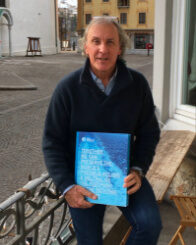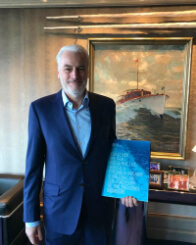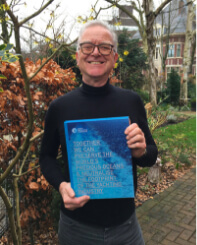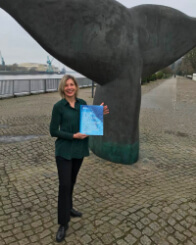1. We recognize that, as the superyacht industry, we owe it to our strategic position to drive change.
The superyacht industry is in a unique strategic position. We are blessed with extraordinarily influential clients who have the ability to drive sustainability and make a truly positive impact. By co-creating cutting-edge innovations that find their way to other (maritime) industries, the superyacht industry can function as Formula 1 functions to the car industry. Each new build project should be viewed as an opportunity to develop and embrace technology that pushes the boundaries, reducing the otherwise long time-to-market of such inventions. New technologies can also be installed during maintenance and refit operations of the existing superyacht fleet in order to upgrade existing yachts. With clients that can make a real difference, we are in a strategic position to facilitate this.
2. We are determined to protect the oceans from degradation, to support ocean conservation, and to leave the oceans in better shape than before.
The oceans are the most critical natural resource for the superyacht industry. They are irreplaceable and technology cannot provide a substitute. The statistics are sobering. Oceans absorb 30% of the CO2 that is released into the atmosphere. However, as the CO2 levels in the atmosphere rise, the levels in the ocean do too, increasing their acidity and affecting many ocean species (National Oceanic and Atmosphere Administration). We must take action now. Not only to ensure the future of our industry, but that of life on planet Earth.
3. We respect the oceans as they are a crucial stakeholder of the superyacht industry.
We sail the world’s oceans to enjoy the beauty of nature. Without a healthy ocean to enjoy, there is little reason for yachting. In this way, the superyacht industry is the only maritime sector that directly depends on the health of the oceans. The healthier the oceans, with flourishing marine life and colourful corals, the more attractive yachting becomes. Oceans are therefore crucial stakeholders to our industry, and it is time we treated them as such by becoming stewards of these life-supporting systems.
4. We commit to sustainable consumption of natural resources and impact-free production to meet the needs of the present and future generations.
It goes without saying that harming nature or polluting oceans is directly in conflict with that what drives our industry. It’s our responsibility to ensure yachting is free from negative impact and nurtures its most important natural resource: the oceans.
As an industry, we use natural resources which we need to manage responsibly. Luxury should not come at the cost of nature or add to the endangerment of species. At all times, we need to refrain from exploitation and negative impact on nature and local communities that could cause conflict.
5. Each person and organisation take individual responsibility from their position to drive positive change.
Get started now. There is a lot that can be done, even from your own backyard. We all have the responsibility to continuously improve on what is within our direct reach. We each have more influence than you may think, not to mention how we can inspire or help others.
6. We actively propose sustainable solutions to our clients and demand sustainable solutions from our suppliers.
We are all part of the supply chain that makes up the life cycle of a yacht. We are impacted by the person in the chain before us and our decisions impact those after us. It’s important that we realize that the choices we offer, or decisions we take, will affect the rest of the supply chain. At the same time, we are all in a position to request a better product or service from our suppliers. This will have a snowball effect and result in a more sustainable superyacht industry.
7. We support the mission of Water Revolution Foundation and embrace its sustainable solutions and tools to drive sustainability in the superyacht industry.
To future proof the superyacht industry, reducing our environmental footprint and preserving the world’s oceans is vital. Water Revolution Foundation started from within the superyacht industry in order to provide the platform for collaboration and to develop the tools needed to drive sustainability. To succeed, the superyacht industry must collaborate and coordinate, setting standards and sharing solutions, working with the same set of tools and in the same direction.
8. We recognize that our future is relevant only when we conduct business in a sustainable way, sharing knowledge and information in order to reduce the superyacht industry’s environmental footprint.
There is no plan B for the planet, nor a plan B for the superyacht industry. While we cater to a very niche market, this is no excuse, nor is it a reason for exemption. In fact, it gives us more responsibility to utilize our unique position. We need to overcome our reservations and realise the potential of sharing knowledge and information. Together we can achieve more, and faster.
9. We embrace the UN 2030 Agenda for Sustainable Development as the foundation for our plan of action for people, planet and prosperity.
The world is rapidly waking up to the consequences of unsustainable use of natural resources and pollution caused by human behaviour. The superyacht industry cannot be an exception to the internationally-coordinated efforts and needs to align itself with the Sustainable Development Goals set by the UN so that we can turn the tide before it is too late.
10. As we embark on this collective journey, we take the responsibility that everyone in this industry is empowered to join our Revolution.
In a sustainable world, no one is left behind as we need each other to make the necessary changes. The same can be said for our industry. In order to future-proof our industry, we must work together. Sustainability is no competition; it is our responsibility to future generations.






